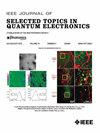Optical Imaging of Microvascular Function in the Brain
IF 5.1
2区 工程技术
Q1 ENGINEERING, ELECTRICAL & ELECTRONIC
IEEE Journal of Selected Topics in Quantum Electronics
Pub Date : 2025-03-11
DOI:10.1109/JSTQE.2025.3550356
引用次数: 0
Abstract
Maintaining adequate cerebral blood flow is essential for normal brain function. Cerebral arteries are responsible for providing sufficient blood supply, which is dependent on systemic blood pressure and thus cardiac output. Cerebral capillaries play a critical role in delivering blood to meet the local needs of neural activity. Their narrow lumen interacts with blood cells, creating resistance to blood flow in the parenchymal tissue. Therefore, the relationship between arterial blood pressure and capillary resistance is critical in determining blood perfusion in the brain. However, the regulatory mechanism of capillary resistance has received less attention compared to the management of arterial blood pressure in maintaining healthy cerebral perfusion. This article summarizes the methodological contributions of optical imaging to the characterization of capillary resistances by microvascular function in the brain, including: i) three-dimensional imaging and quantification methods used in preclinical studies to determine spatial variations in microvascular structures in the cortex, ii) fluorescence imaging techniques for mapping the temporal dynamics of microvascular flow, and iii) understanding microvascular function in response to global changes induced by systemic physiology and local variations in neural network activities. Finally, potential technical advances in optical tools for diagnosis of brain microvascular function are discussed.脑微血管功能的光学成像
维持充足的脑血流量对正常的脑功能至关重要。脑动脉负责提供足够的血液供应,这取决于全身血压,因此心输出量。脑毛细血管在输送血液以满足局部神经活动的需要方面起着关键作用。它们狭窄的管腔与血细胞相互作用,对实质组织中的血液流动产生阻力。因此,动脉血压和毛细血管阻力之间的关系对于确定脑内血流灌注至关重要。然而,与动脉血压管理相比,毛细血管阻力的调节机制在维持健康的脑灌注方面受到的关注较少。本文综述了光学成像在脑微血管功能表征毛细血管阻力方面的方法学贡献,包括:I)用于临床前研究的三维成像和量化方法,以确定皮层微血管结构的空间变化;ii)荧光成像技术,用于绘制微血管流动的时间动态;iii)了解微血管功能对系统生理和局部神经网络活动变化引起的全局变化的响应。最后,讨论了用于脑微血管功能诊断的光学工具的潜在技术进展。
本文章由计算机程序翻译,如有差异,请以英文原文为准。
求助全文
约1分钟内获得全文
求助全文
来源期刊

IEEE Journal of Selected Topics in Quantum Electronics
工程技术-工程:电子与电气
CiteScore
10.60
自引率
2.00%
发文量
212
审稿时长
3 months
期刊介绍:
Papers published in the IEEE Journal of Selected Topics in Quantum Electronics fall within the broad field of science and technology of quantum electronics of a device, subsystem, or system-oriented nature. Each issue is devoted to a specific topic within this broad spectrum. Announcements of the topical areas planned for future issues, along with deadlines for receipt of manuscripts, are published in this Journal and in the IEEE Journal of Quantum Electronics. Generally, the scope of manuscripts appropriate to this Journal is the same as that for the IEEE Journal of Quantum Electronics. Manuscripts are published that report original theoretical and/or experimental research results that advance the scientific and technological base of quantum electronics devices, systems, or applications. The Journal is dedicated toward publishing research results that advance the state of the art or add to the understanding of the generation, amplification, modulation, detection, waveguiding, or propagation characteristics of coherent electromagnetic radiation having sub-millimeter and shorter wavelengths. In order to be suitable for publication in this Journal, the content of manuscripts concerned with subject-related research must have a potential impact on advancing the technological base of quantum electronic devices, systems, and/or applications. Potential authors of subject-related research have the responsibility of pointing out this potential impact. System-oriented manuscripts must be concerned with systems that perform a function previously unavailable or that outperform previously established systems that did not use quantum electronic components or concepts. Tutorial and review papers are by invitation only.
 求助内容:
求助内容: 应助结果提醒方式:
应助结果提醒方式:


